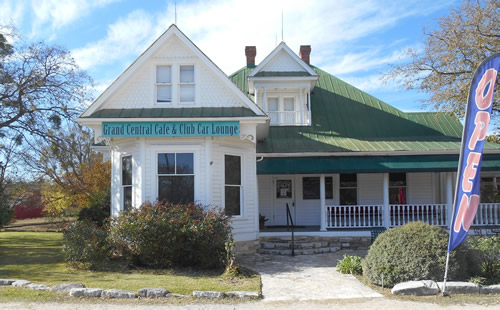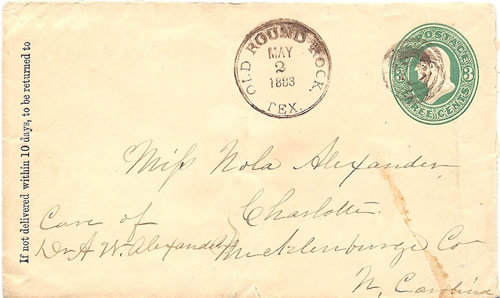Round Rock, Texas, Willliamson County. (original) (raw)
History in a Pecan Shell
Historical Marker (On Main Street):
ROUND ROCK
Permanent settlement began in this area in the late 1830s. By 1848, former Austin Mayor Jacob Harrell moved here, selling town lots near the Stagecoach Road crossing at Brushy Creek. A post office named �Brushy Creek� opened in 1851 in Thomas Oatts� store. Three years later, the name changed to �Round Rock� for a distinctive limestone formation marking a natural ford for wagons.
With immigration from several states and Sweden, the population doubled during the 1850s, bringing new stores, churches, fraternal lodges and grain mills. The first institution of higher learning, Round Rock Academy, began in 1862. After the Civil War, the former trail and stage road became a prominent cattle drive route. In 1876, the International-Great Northern Railroad developed a new townsite east of the existing Round Rock. A commercial district sprang up along Georgetown Avenue (Main Street) with construction of many limestone buildings. �New Town� quickly eclipsed the established settlement, whose postal name changed again to �Old Round Rock.� For months, the new site was the railroad terminus, bringing lumber and flour mills, cotton gins, blacksmith and wagon shops, banks, hotels, restaurants, stores and schools. Round Rock challenged the state capital for economic control of central Texas, boasting six hotels to Austin�s five and serving as the retail hub for several counties to the west. The railroad also made Round Rock a more cosmopolitan place, bringing new residents from all over the U.S. And all around the world.
Well-positioned for growth by its location on major transportation routes, Round Rock became one of the nation�s fastest-growing cities by the late 20th century. Two dozen commercial buildings in Round Rock�s historic downtown were listed in the National Register of Historic Places in 1983.
2009
Round Rock, Texas
Landmarks & Attractions

The 1894 Palm Valley Lutheran Church and Cemetery
Photo courtesy Barclay Gibson, April 2005
Round Rock Attractions
- Palm Valley Lutheran Church
- The Palm House Museum
212 East Main Street
Monday to Saturday 9:30 am to 5:00 pm
Sunday 1:00 - 5:00 pm - Round Rock Hotels › Book Here

The 1894 Palm Valley Lutheran Church
2500 Palm Valley Blvd
Recorded Texas Historic Landmark
Photo courtesy Barclay Gibson, April 2005
Historical Marker ( 2500 Palm Valley Blvd ):
Palm Valley Lutheran Church
In area first claimed in 1838 by white men. Valley bears name of the Anna Palm family, 1853 Swedish settlers. "Brushy", the first Lutheran church (of logs), was built here by Andrew John Nelson and 3 hired men in 1861. This also housed early school. Congregation was formally organized Nov. 27, 1870. Second church, built 1872, was used for sessions of Palm Valley School. Present Gothic Revival style building was erected in 1894.
Recorded Texas Historic Landmark - 1970


Historical Marker ( Sam Bass Rd ):
Round Rock Cemetery
Established in the early 1850s in what is now known as Old Round Rock, this cemetery is the burial ground of many area pioneers and outstanding Round Rock citizens. The oldest legible tombstone, which marks the burial site of 11-year-old Angeline Scott, bears the year 1851, although there are many unmarked graves that could date from before that time. One-half acre in the northwest part of the 4.5-acre cemetery was used as a burial ground for slaves and freedmen during the nineteenth century. Numerous war veterans are buried here, as is bank robber and outlaw Sam Bass, who died July 21, 1878, two days after being shot by Texas Rangers in Round Rock. Other buried in the cemetery include G. T. Cole, one of the few area eye doctors; Round Rock broom factory owner Sam Landrum; stonemason John H. Gray; Round Rock Presbyterian Church minister John Hudson; and Methodist circuit rider J. W. Ledbetter. One unusual tombstone, which marks the gravesite of Mary Ann Lavender, bears the date February 30, 1870.
The Round Rock Cemetery, which contains more than 2,000 graves, is a visible reminder of the early history of this part of Williamson County. The burial ground is cared for by the Round Rock Cemetery Association. (1983)
Historical Marker ( 203 Commerce ):Round Rock Volunteer Fire DepartmentThe Hose and Hand Pump Company was formed in 1884 as Round Rock's first organized fire department. Money for equipment was raised through donations, picnics, dances, box suppers, and other fund drives. The first building constructed for Round Rock's fire department was completed in 1892. About 1934, the department purchased its first piece of motor-driven equipment--a Model T Ford chassis. As one of the state's oldest volunteer fire departments, it continues to provide significant service to the citizens of Round Rock.
(1984)
Our Visit to Round Rock
Yes, there really was a Round Rock, and you can even see it. Judge for yourself if it even looks remotely round. Although its population and proximity toAustin make it seem out of place, we're including it for it's abundant limestone buildings. It's also a pleasant place to play hooky from Austin. Remember when Austin was a hooky player's destination?
The Chamber of Commerce has some old photographs and memorabilia of the town displayed in a comfortable setting. Look them over before entering the Chamber proper. Be prepared for a very businesslike atmosphere toward the back. This is not a small town, remember. Their colorful brochure is representative of the tightrope they seem to be walking between the past and the future. An excellent, easy to read map shows all points of interest and then some. The Round Rock is mentioned as well as the historical buildings, downtown, and the cemetery where Sam Bass is buried.
I once chided Round Rock about Sam Bass Road. I had written that Gonzales would never have named a street after John Wesley Hardin, even though he once practiced law there. Imagine my surprise when I picked up The Story of Sam Bass, in the Chamber of Commerce and read an anonymous biography that was harder on him than I had been. We both used the word "inept" and the phrase "blown out of proportion". His name isn't even remotely euphonic, and is missing the all-important third name like John Wesley Hardin or Billy the Kid. So why did he become a legend?
Round Rock Chamber of Commerce
212 East Main Street
1-512-255-5805, 1-800-747-3479
http://www.roundrockchamber.org/
Round Rock, Texas Legends
- The Hairy Man of Round Rock by Maggie Van Ostrand
"Round Rock's Hairy Man's the real thing and he's been there back since pioneers built cabins and helped conquer the West...
To this day, the Hairy Man's ghost roams along the same shady road upon which he had died such a grisly death, doomed forever to seek return of the life that was so violently ripped from him.
Kindly Texans have since tried to make it up to him by celebrating an annual Hairy Man Festival each October, Halloween month. There are food, fun, and festivities galore, including a Hairy Man Contest... more" - Soapy Smith by Clay CoppedgeOn Sam Bass
- The short life of Sam Bass by Bob Bowman
For more than four years, we have been working on a new book, �Bad to the Bone,� a collection of outlaws who left their imprint on East Texas. One of the best known outlaws was Sam Bass... more - Sam Bass: The Not So Merry Bandit by Clay Coppedge
If notorious Old West bandit Sam Bass buried all the gold he is said to have buried in Central Texas, he would have been a wealthy man indeed. He wouldn't have made the fatal decision to rob a bank in Round Rock in July of 1878. He would simply have stopped by one of the caves where millions of his dollars are said to have been buried, and hightailed it to Mexico, incognito. Likewise, if he stopped by every place he is said to have been sighted on that ill-fated trip to Round Rock... more - Texas outlaw Sam Bass inspired tall tales by Murray Montgomery
He was only 27 years old when he met his maker, but during his short life he became the subject of cowboy songs and tall tales which were told around many a campfire in Texas...more
Historical Marker (W. Main Street at Round Rock Ave., Round Rock): Sam Bass' Death Site An uneducated Indiana orphan who drifted to Texas as a youth, Sam Bass won fame racing his swift "Denton Mare," gambling, and robbing trains. A rich haul in Nebraska was followed by months of reckless spending. Bass liked to shower gold on people who fed or harbored him while he eluded law officers. In July 1878 he came to Round Rock to rob a bank, and was shot by Texas Rangers. Gallant to the last, refusing to name guilty partners, he became a hero to 19th century balladeers. His celebrated grave is situated in old Round Rock Cemetery.
1981
More Texas Outlaws





Texas Escapes, in its purpose to preserve historic, endangered and vanishing Texas, asks that anyone wishing to share their local history, stories, landmarks and recent or vintage photos, please contact us.
